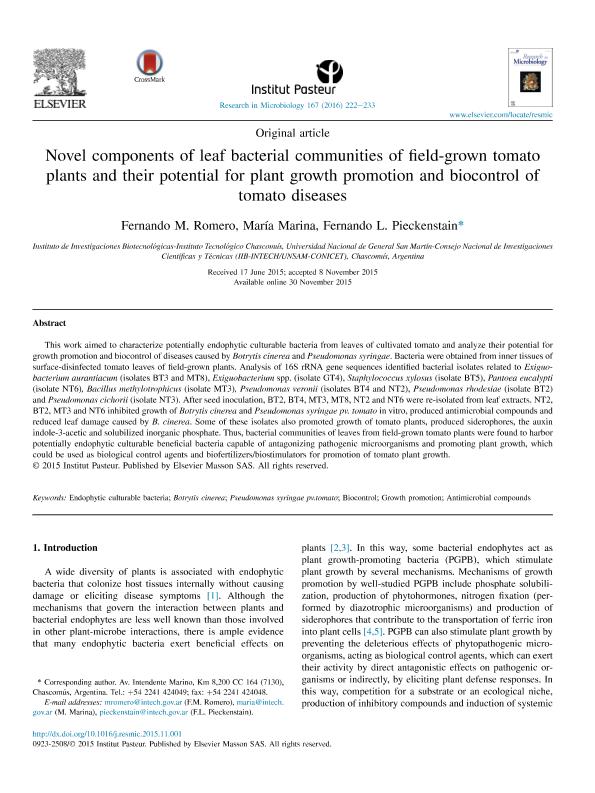Mostrar el registro sencillo del ítem
dc.contributor.author
Romero, Fernando Matias

dc.contributor.author
Marina, María

dc.contributor.author
Pieckenstain, Fernando Luis

dc.date.available
2018-07-31T20:30:23Z
dc.date.issued
2016-04
dc.identifier.citation
Romero, Fernando Matias; Marina, María; Pieckenstain, Fernando Luis; Novel components of leaf bacterial communities of field-grown tomato plants and their potential for plant growth promotion and biocontrol of tomato diseases; Elsevier Science; Research In Microbiology; 167; 3; 4-2016; 222-233
dc.identifier.issn
0923-2508
dc.identifier.uri
http://hdl.handle.net/11336/53682
dc.description.abstract
This work aimed to characterize potentially endophytic culturable bacteria from leaves of cultivated tomato and analyze their potential for growth promotion and biocontrol of diseases caused by Botrytis cinerea and Pseudomonas syringae. Bacteria were obtained from inner tissues of surface-disinfected tomato leaves of field-grown plants. Analysis of 16S rRNA gene sequences identified bacterial isolates related to Exiguobacterium aurantiacum (isolates BT3 and MT8), Exiguobacterium spp. (isolate GT4), Staphylococcus xylosus (isolate BT5), Pantoea eucalypti (isolate NT6), Bacillus methylotrophicus (isolate MT3), Pseudomonas veronii (isolates BT4 and NT2), Pseudomonas rhodesiae (isolate BT2) and Pseudomonas cichorii (isolate NT3). After seed inoculation, BT2, BT4, MT3, MT8, NT2 and NT6 were re-isolated from leaf extracts. NT2, BT2, MT3 and NT6 inhibited growth of Botrytis cinerea and Pseudomonas syringae pv. tomato in vitro, produced antimicrobial compounds and reduced leaf damage caused by B. cinerea. Some of these isolates also promoted growth of tomato plants, produced siderophores, the auxin indole-3-acetic and solubilized inorganic phosphate. Thus, bacterial communities of leaves from field-grown tomato plants were found to harbor potentially endophytic culturable beneficial bacteria capable of antagonizing pathogenic microorganisms and promoting plant growth, which could be used as biological control agents and biofertilizers/biostimulators for promotion of tomato plant growth.
dc.format
application/pdf
dc.language.iso
eng
dc.publisher
Elsevier Science

dc.rights
info:eu-repo/semantics/openAccess
dc.rights.uri
https://creativecommons.org/licenses/by-nc-nd/2.5/ar/
dc.subject
Antimicrobial Compounds
dc.subject
Biocontrol
dc.subject
Botrytis Cinerea
dc.subject
Endophytic Culturable Bacteria
dc.subject
Growth Promotion
dc.subject
Pseudomonas Syringae Pv.Tomato
dc.subject.classification
Biología Celular, Microbiología

dc.subject.classification
Ciencias Biológicas

dc.subject.classification
CIENCIAS NATURALES Y EXACTAS

dc.title
Novel components of leaf bacterial communities of field-grown tomato plants and their potential for plant growth promotion and biocontrol of tomato diseases
dc.type
info:eu-repo/semantics/article
dc.type
info:ar-repo/semantics/artículo
dc.type
info:eu-repo/semantics/publishedVersion
dc.date.updated
2018-07-31T17:22:02Z
dc.journal.volume
167
dc.journal.number
3
dc.journal.pagination
222-233
dc.journal.pais
Países Bajos

dc.journal.ciudad
Amsterdam
dc.description.fil
Fil: Romero, Fernando Matias. Consejo Nacional de Investigaciones Científicas y Técnicas. Centro Científico Tecnológico Conicet - La Plata. Instituto de Investigaciones Biotecnológicas. Instituto de Investigaciones Biotecnológicas ; Argentina
dc.description.fil
Fil: Marina, María. Consejo Nacional de Investigaciones Científicas y Técnicas. Centro Científico Tecnológico Conicet - La Plata. Instituto de Investigaciones Biotecnológicas. Instituto de Investigaciones Biotecnológicas ; Argentina
dc.description.fil
Fil: Pieckenstain, Fernando Luis. Consejo Nacional de Investigaciones Científicas y Técnicas. Centro Científico Tecnológico Conicet - La Plata. Instituto de Investigaciones Biotecnológicas. Instituto de Investigaciones Biotecnológicas ; Argentina
dc.journal.title
Research In Microbiology

dc.relation.alternativeid
info:eu-repo/semantics/altIdentifier/doi/http://dx.doi.org/10.1016/j.resmic.2015.11.001
dc.relation.alternativeid
info:eu-repo/semantics/altIdentifier/url/https://www.sciencedirect.com/science/article/pii/S0923250815001977
Archivos asociados
